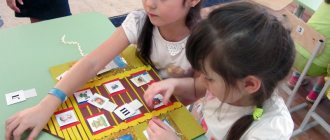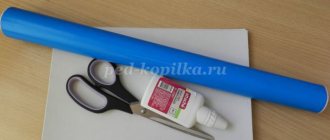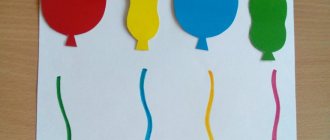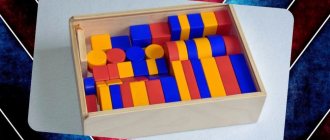Middle group. Junior preschool age. Children 4 - 5 years old
Card index of games on eidetics for children of the middle group Eidetics is a branch of psychology that studies eidetism as a type of figurative memory and the possibility of its practical application in different spheres of human life. Eidetics uses all the child’s analyzers: it allows not only to see, but also to touch, hear,...
Card index of games for speech development in the middle group using the Pop It toy Card index of games for speech development in the middle group using the Pop It toy. No. 1Game “If you hear the word”
Goal: To develop auditory perception, speech hearing. Progress of the game: Option 1: The teacher pronounces the words. Assignment: children press a blue circle if they hear...
Card index of didactic games in the 1st junior group of preschool educational institutions
Card index of didactic games
in 1st junior group
Didactic games to familiarize children with the colors of objects
"Find and name"
Didactic task: To introduce children to characteristic natural phenomena for autumn: yellow leaves.
Material: autumn leaves.
"Find the checkbox"
Didactic task: To introduce children to the red color of objects. Teach children to recognize and name a red flag.
Material: flags.
"Find and name"
Didactic task: Teach children to recognize and name vegetables. Pay attention to their color: tomatoes are red, turnips are yellow.
Material: vegetables.
"Paired pictures"
Didactic task: Teach children to find identical pictures of vegetables, naming their color: red, yellow.
Material: paired pictures depicting vegetables.
"Find the same one"
Didactic task: Teach children to group objects by color: red to red, yellow to yellow.
Material: red and yellow cubes.
"Pick up a feather"
Didactic task: Teach children to name and distinguish between red and yellow colors. Teach children to group objects by color.
Material: picture of a rooster with a bushy tail, not painted, where the feathers are slits. Feathers of two colors: red and yellow.
“Collect and name what color”
Didactic task: To introduce children to the green color of objects. Fix children's attention on the fact that color is the main feature of different objects and can be used to designate them.
Material: green pyramids, consisting of rings of the same size.
“Let’s plant flowers near the houses”
Didactic task: To teach children to correlate dissimilar objects by color: red flowers to a red house, yellow flowers to a yellow house in a green meadow. Exercise children in distinguishing colors: red, yellow, green.
Material: houses, flowers, clearing.
"Multi-colored beads"
Didactic task: Teach children to alternate objects by color: red, yellow, green.
Material: beads of red, yellow and green colors.
“Help the nesting dolls find their house”
Didactic task: Continue to teach children to distinguish and name the colors red, yellow, green and blue. Teach children to correlate dissimilar objects by color: a blue nesting doll to a blue house, etc.
Material: houses and nesting dolls in primary colors.
“Help the nesting dolls find their beads”
Didactic task: Exercise children in distinguishing primary colors. Continue to teach children to correlate dissimilar objects by color: red beads to a red nesting doll, etc.
Material: nesting dolls and beads of primary colors.
“Laying out a mosaic on the theme “The goslings went to the river for a walk””
Didactic task: To introduce children to the blue color of objects. Fix children's attention on the characteristic color properties of objects.
Material: yellow and blue mosaic elements.
"Errands"
Didactic task: Teach children to name and distinguish toys, indicating their primary colors.
Material: balls - red and blue, Christmas tree - green, cars - blue and red.
"Sort by color"
Didactic task: Teach children to group homogeneous objects by color.
Material: mushrooms with caps of different colors: three mushrooms of each color.
“Pick up a string for the ball”
Didactic task: Continue to teach children to match objects by color: red thread to red ball, etc.
Material: demonstration material: flannelgraph, strips and circles of colored cardboard.
“Match the saucers to the cups”
Didactic task: Continue to teach children to match objects by color: yellow saucer to yellow cup, etc.
Material: flannelgraph, cardboard saucers and cups.
"Choose by color"
Didactic task: To consolidate in children the ability to select objects by color.
Material: each child has a card divided into 4 squares of primary colors, small toys of the same colors.
"Hide the mouse"
Didactic task: To train children in the ability to select objects by color: a blue door to a blue house where a mouse lives, etc.
Material: Large and small cards in the middle with a mouse, doors of the same colors, a cat toy.
"Make a picture"
Didactic task: Teach children to make a picture of a whole object from two to four parts.
Material: cut-out pictures - samples.
"Fold the flower"
Didactic task: Continue to teach children to compose whole objects from three parts.
Material: cut flowers of primary colors.
Didactic games to familiarize children with the size of objects
"Make a tower"
Didactic task: Teach children to name and distinguish the size of objects: large, small. To develop children's understanding of these words.
Material: Homogeneous pyramids consisting of large and small rings.
“What's there? "
Didactic task: Teach children to compare objects by size: small, large.
Material: nesting dolls: large double and small one-piece.
"Which ball is bigger"
Didactic task: Teach children to find objects of different sizes, naming their basic properties: size and color.
Material: large and small balls.
"Find and name"
Didactic task: To introduce children to the characteristic natural phenomena of autumn: yellow and red leaves. Teach children to name and distinguish objects by size: large, small.
Material: leaves large and small.
"Let's assemble a pyramid"
Didactic task: To train children in the ability to assemble a pyramid: remove and string rings. Teach children to find objects of the same size by placing one object on top of another.
Material: pyramids of five rings; two rings of the same size.
“Lay out the cubes”
Didactic task: Teach children to group objects by size: large, small.
Material: large and small red cubes.
"Find out and name"
Didactic task: Teach children to recognize and name vegetables, group vegetables by size.
Material: large and small vegetables.
"Sort by size"
Didactic task: Continue to teach children to group objects by size.
Material: Mushrooms made of cardboard of different sizes.
"Big and Small"
Didactic task: Continue to teach children to name and distinguish objects in pictures by size.
Material: pictures depicting objects of different sizes.
“Match the saucers to the cups”
Didactic task: Teach children to correlate objects by size: large saucers to large cups, small saucers to small cups.
Material: flannelgraph, cardboard saucers and cups of different sizes.
“Help the nesting dolls find their house”
Didactic task: Continue teaching children to correlate objects by size: a large nesting doll to a big house, a small matryoshka to a small house.
Material: Matryoshka dolls and houses of different sizes.
“Help the nesting dolls find their beads”
Didactic task: Continue to teach children to correlate objects by size.
Material: beads and nesting dolls of different sizes.
"Collect the beads"
Didactic task: Teach children to alternate elements by size.
Material: Fishing line, beads of different sizes.
“Help the nesting dolls find their ribbon”
Didactic task: Teaches children to correlate objects by size: for a large matryoshka a wide ribbon, for a small matryoshka a narrow ribbon. Teach children to distinguish and name the size of an object: narrow, wide.
Material: Matryoshka dolls, ribbons - wide, narrow.
"Errands"
Didactic task: Teach children to recognize and name toys, indicating their properties - color, size - large, small, narrow, wide.
Material: toys of different sizes.
“How the animals were driven by cars”
Didactic task: Continue to teach children to correlate objects by size: large animals on a large car, small animals on a small one. The hare has a short tail, the fox has a long tail.
Material: cars and toys of different sizes.
“Let’s help the doll Katya get dressed for a walk”
Didactic task: Teach children to remember the names of clothes and shoes; the sequence of dressing for a walk, indicating their color, size: hat - small, scarf - long, boots - short.
Material: doll with a set of clothes.
“Let’s decorate the Christmas tree with toys”
Didactic task: Teach children to name the size of objects decorating the Christmas tree.
Material: flannelgraph, Christmas tree and colored cardboard toys.
"Who Stomps"
Didactic task: Exercise children in naming the size of objects: the big bear stomps loudly, the small one quietly.
Material: screen, bear toys of different sizes.
"Narrow, wide"
Didactic task: To clarify children’s understanding of size: narrow, wide.
Material: flowers with narrow and wide leaves.
Didactic games to familiarize children with the shape of objects
"Find your house"
Didactic task: Teach children to feel the contour and hole of geometric shapes.
Material: game-panel with holes, inserts of geometric shapes: circle, square, rectangle, triangle.
"Find out and name"
Didactic task: To introduce children to the round shape of an object.
Material: tomato, apple, orange.
"Let's build a tower of rings"
Didactic task: Teach children to determine the round shape of an object by feeling it with their fingers.
Material: pyramids.
"Beads for dolls"
Didactic task: Continue to teach children to name the round shape of an object.
Material: beads, fishing line, dolls.
Didactic games for the younger group of kindergarten on the topic: “Nature. Animals. Birds. Flowers".
Find a leaf.
Goal: distinguish and name the leaves of familiar trees, remember the names of trees, develop children’s speech; to cultivate their attention and aesthetic feelings.
Material: each child has identical bouquets of 3-4 leaves (maple, oak, ash, birch), one bouquet from the teacher.
Guess what's in your hand.
Goal: to teach children to distinguish and name vegetables and fruits by color, shape; cultivate an interest in nature.
Material: vegetables and fruits.
Trees and their fruits.
Goal: to teach children to select tree fruits, to develop visual memory and attention.
Material: illustrations of trees (spruce, rowan, chestnut, linden, maple) pictures (cone, rowan, chestnut, linden seeds, maple lionfish).
Name the bird.
Goal: to teach children to recognize and name birds; develop visual memory and thinking; cultivate a love for nature.
Material: pictures of birds (sparrow, dove, crow, swallow, starling, tit).
Which flower is gone?
Goal: to teach children to name the flowers of the “corner of nature” (tradescantia, violet, Amazonian lily, begonia), to develop visual memory, and to cultivate a desire to take care of plants.
Material: flowers from a “nature corner”.
Care for flowers.
Goal: to strengthen children’s ability to care for the plants of the “nature corner”; choose the right things to care for; develop memory, attentiveness, and cultivate a desire to take care of plants.
Material: watering can; rag; stick for loosening; a spray bottle and things unnecessary for care (toy, stone, book, etc.).
Flower shop.
Goal: to consolidate the names and external characteristics of flowers growing in the “corner of nature”; learn to describe plants in two or three sentences, develop coherent speech and memory.
Material: plants from the “nature corner”.
Who lives in the forest?
Goal: to consolidate children's knowledge about wild animals; develop memory, speech; cultivate a love for animals.
Material: toy sets: “Wild Animals” and “Pets”.
Find a flower.
Goal: to strengthen children’s ability to find and name the flowers of the “nature corner”.
Material: flowers from a “nature corner”.
Magic bag.
Goal: to strengthen children’s ability to name vegetables and their color; develop visual memory and attention.
Material: “magic bag”, vegetables.
Find out the animal.
Goal: to strengthen children’s ability to recognize domestic animals by their sounds; develop phonemic hearing and attention.
Vegetables and fruits.
Goal: to strengthen children’s ability to find named vegetables or fruits, to develop attention and memory.
Material: dummies of vegetables and fruits.
Name the tree.
Goal: to teach children to recognize and name trees on the street; develop visual memory, cultivate a love of nature.
Material: trees on the street area.
What tree is the leaf from?
Goal: to teach children to recognize and name leaves from trees, to develop visual memory and attention.
Material: dried leaves from trees, bell.
You will find out by the description.
Goal: to teach children to recognize trees and bushes by description; develop attentiveness and memory.
Who's the odd one out?
Goal: to teach children to choose the odd one out of a number of animals, explain why it is odd; develop logical thinking and attentiveness.
Material: pictures with wild animals and one domestic animal, bird, flower, insect, typesetting canvas.
Who is screaming?
Goal: to strengthen children’s ability to make bird sounds; develop mindfulness and cultivate a love of nature.
Material: pictures depicting a crow, tit, sparrow, woodpecker, owl.
Which bird is gone.
Goal: continue to teach children to recognize and name birds; develop visual memory, attentiveness and diligence.
Material: cards with images of birds, typesetting canvas.
Name of the bird.
Goal: continue to teach children to recognize and name migratory birds; develop memory, attention; cultivate a love for birds.
Material: cards with images of birds (swallow, starling, crane).
Library
The literature card file occupies an important place in an educational institution. Readers receive information about it thanks to:
- visual information;
- events, conversations, excursions;
- days of bibliography;
- publication of manuals;
- use of forms and methods of library activities.
The system of catalogs and cards in the library is managed through planning, coordination, and control. The work of employees in this area consists of drawing up plans, developing documentation, and monitoring completed activities. Each library card is subject to maintenance and editing, for which employees are responsible according to their job description.
Concept
A card index is a record of documents arranged in alphabetical order. There may also be a distribution by deadlines and topics. Thanks to the fact that everything is located in one department of the enterprise, finding any information will not be difficult.
What is a card index in a library? These are catalogs that allow you to quickly find books of interest, because all readers come to receive specific information. Without them, it would be difficult to navigate any library.
Card file of arbitration cases
The judicial system has mastered new trends much faster than the medical system. At the moment, in most countries of the world, computer databases are being created that contain information on cases that are or have been before arbitration courts of all levels and entities.
In the Russian Federation this is the Card Index of Arbitration Cases. It is a website kad.arbitr.ru, where, using various search parameters, you can find all the necessary data about the court decision, if for some reason they are not classified. This resource inherited its name from a system used in the pre-computer era. While in the same Ukraine, a site with such data is called not a “card index”, but a “register” (“Unified State Register of Ship Decisions”).
And also about the law enforcement system. As is known, from the moment of its formation, all countries of the world began to keep records of persons who had previously committed crimes or were suspected of them.
Today, all this information is no longer stored in dusty folders, but has been digitized and entered into computer databases.
In the Russian Federation, the “Card Index” program has been developed to store information from the forensic expert department of the Ministry of Internal Affairs and about registered persons. We can assume that its name is another way of interpreting the term in question.
Features of filing cabinets in hospitals
The filing cards include essential patient information. There you can find information about your health status, medical history, and prescribed medications. The document allows you to transfer data from one doctor to another.
Cards are stored on special racks, where everything is arranged in alphabetical order. Furniture for documentation can be ordered to specific sizes. The racks have a depth of 18-25 cm and a width of 1000 mm. Many companies manufacture custom-made furniture based on customer preferences.
There is mobile rail furniture for the archive department. It will help compactly place the necessary materials in small areas. The reception area may have stationary shelving or combined furniture. Properly placed documentation will allow you to quickly find the card you need.
Banking industry
What is a card index in a bank? This term implies accounting for payment documents that the bank has not fulfilled. The institution keeps them under control. The file cabinet can be of different types, depending on the reasons for unpaid obligations.
These may be orders that were not executed due to lack of funds. Then the employee registers the document in electronic and paper form. This payment will be in an off-balance sheet account. The account owner is informed that the document has been queued. Once received, the funds are credited to the desired account. The file cabinet stores documents that require consent to perform a payment transaction, as well as those that are awaiting their turn.
The presence of a file cabinet indicates that the company has an unstable financial position. If the account owner does not have it, then the bank offers a line of credit or an additional one. financing.
The sequence is the order in which payment orders are executed. It is approved by law. Documents are not processed ahead of the queue. If the account has the required amount, then everything goes by date. If the necessary funds are not available, the following queue is established:
- execution of orders for damage compensation;
- payment of salaries, sick leave, vacations;
- tax payments;
- sending money to funds;
- other requirements.
Document storage rules
The archive is maintained by a special employee who works on the basis of a job description. The employee ensures the reception, recording and storage of documentation. It carries out information and reference activities, as well as organizational and methodological ones.
At each enterprise, the archive is located in a separate room. Only as an exception, racks, cabinets, and safes are used that perform the function of preserving documentation. Their shelf life is determined to be 3 years, but it can be reduced.
After this period has expired, it is determined whether the document will be used or archived forever. There is also a destruction option. What exactly needs to be done is decided on the basis of an expert commission.
Directory types
The card file includes many catalogs, which may differ in purpose, coverage of the fund, grouping method, technology of creation and use.
If we consider the purpose, then catalogs are for readers and for service purposes. They contain, for example, information of interest to readers. Based on the coverage of collections, catalogs can include useful information about institutions, as well as about specific library departments.
According to the grouping method, cards are:
- alphabetical;
- systematic.
The first is presented in the form of a catalog where the data is listed in alphabetical order. To quickly find the book you need, you need to find the author's name or the title of the work. Using such a catalog is very convenient.
A systematic catalog is a catalog in which information is located by field of knowledge. For this purpose, the principles of library and bibliographic classification are used, which prescribe the rules for grouping information. Considering the type of creation and use, file cabinets can be traditional or electronic.
Medical databases
If, with the advent of electronic books, people go to the library much less often, preferring to download everything and read on a computer, then a medical file is something that one has to deal with against one’s own will.
In any medical institution (no matter public or private), each patient has his own card. It stores all the secrets about his health (symptoms, test results, treatment, doctor’s orders, extracts from the medical history).
It is interesting that although all these “cards” are in practice more like brochures or small books, they continue to bear their traditional name. The thing is, this system initially really consisted of cardboard cards with data, after which this document is named.
Like all other filing systems, medicine is now widely computerized in more developed countries. We are still just getting there. However, there are already several programs adapted to our realities for maintaining a database of patients, recording the services provided to them in hospitals, clinics and other medical institutions. True, they are specialized for paid clinics, where they are used most often.







